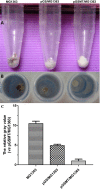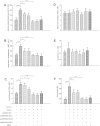Prevention of gastrointestinal lead poisoning using recombinant Lactococcus lactis expressing human metallothionein-I fusion protein
- PMID: 27045906
- PMCID: PMC4820694
- DOI: 10.1038/srep23716
Prevention of gastrointestinal lead poisoning using recombinant Lactococcus lactis expressing human metallothionein-I fusion protein
Abstract
Low-level lead poisoning is an insidious disease that affects millions of children worldwide, leading to biochemical and neurological dysfunctions. Blocking lead uptake via the gastrointestinal tract is an important prevention strategy. With this in mind, we constructed the recombinant Lactococcus lactis strain pGSMT/MG1363, which constitutively expressed the fusion protein glutathione S-transferase (GST)-small molecule ubiquitin-like modifier protein (SUMO)-metallothionein-I (GST-SUMO-MT). The thermodynamic data indicated that the average number of lead bound to a GST-SUMO-MT molecule was 3.655 and this binding reaction was a spontaneous, exothermic and entropy-increasing process. The total lead-binding capacity of pGSMT/MG1363 was 4.11 ± 0.15 mg/g dry mass. Oral administration of pGSMT/MG1363 (1 × 10(10) Colony-Forming Units) to pubertal male rats that were also treated with 5 mg/kg of lead acetate daily significantly inhibited the increase of blood lead levels, the impairment of hepatic function and the decrease of testosterone concentration in the serum, which were all impaired in rats treated by lead acetate alone. Moreover, the administration of pGSMT/MG1363 for 6 weeks did not affect the serum concentration of calcium, magnesium, potassium or sodium ions. This study provides a convenient and economical biomaterial for preventing lead poisoning via the digestive tract.
Figures








Similar articles
-
Subacute safety assessment of recombinant Lactococcus lactis on the gut microbiota of male Sprague-Dawley rats.J Sci Food Agric. 2021 Nov;101(14):5807-5812. doi: 10.1002/jsfa.11231. Epub 2021 Apr 9. J Sci Food Agric. 2021. PMID: 33792042
-
Expression and Purification of glutathione transferase-small ubiquitin-related modifier-metallothionein fusion protein and its neuronal and hepatic protection against D-galactose-induced oxidative damage in mouse model.J Pharmacol Exp Ther. 2009 May;329(2):469-78. doi: 10.1124/jpet.108.149401. Epub 2009 Feb 10. J Pharmacol Exp Ther. 2009. PMID: 19208897
-
Lactococcus lactis expressing food-grade β-galactosidase alleviates lactose intolerance symptoms in post-weaning Balb/c mice.Appl Microbiol Biotechnol. 2012 Dec;96(6):1499-506. doi: 10.1007/s00253-012-3977-4. Epub 2012 Mar 8. Appl Microbiol Biotechnol. 2012. PMID: 22395907
-
[Expression and activity analysis of the human glutathione-S-transferase in Lactococcus lactis].Wei Sheng Wu Xue Bao. 2000 Apr;40(2):132-8. Wei Sheng Wu Xue Bao. 2000. PMID: 12548934 Chinese.
-
Physical and genetic maps of the chromosome of the Lactococcus lactis subsp. lactis strain IL1403 and Lactococcus lactis subsp. cremoris strain MG1363.Dev Biol Stand. 1995;85:597-603. Dev Biol Stand. 1995. PMID: 8586238 Review. No abstract available.
Cited by
-
The association of blood lead levels and renal effects may be modified by genetic combinations of Metallothionein 1A 2A polymorphisms.Sci Rep. 2020 Jun 15;10(1):9603. doi: 10.1038/s41598-020-66645-y. Sci Rep. 2020. PMID: 32541800 Free PMC article.
-
Surface display of PbrR on Escherichia coli and evaluation of the bioavailability of lead associated with engineered cells in mice.Sci Rep. 2018 Apr 9;8(1):5685. doi: 10.1038/s41598-018-24134-3. Sci Rep. 2018. PMID: 29632327 Free PMC article.
-
Engineered bacteria as drug delivery vehicles: Principles and prospects.Eng Microbiol. 2022 Jun 21;2(3):100034. doi: 10.1016/j.engmic.2022.100034. eCollection 2022 Sep. Eng Microbiol. 2022. PMID: 39629029 Free PMC article. Review.
-
Preventive Effect of Limosilactobacillus fermentum SCHY34 on Lead Acetate-Induced Neurological Damage in SD Rats.Front Nutr. 2022 Apr 27;9:852012. doi: 10.3389/fnut.2022.852012. eCollection 2022. Front Nutr. 2022. PMID: 35571929 Free PMC article.
-
Association between acute severe mercury poisoning and multiple organ failure.Am J Transl Res. 2020 Aug 15;12(8):4347-4353. eCollection 2020. Am J Transl Res. 2020. PMID: 32913510 Free PMC article.
References
Publication types
MeSH terms
Substances
LinkOut - more resources
Full Text Sources
Other Literature Sources
Medical
Research Materials

